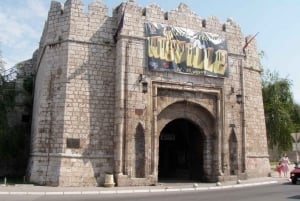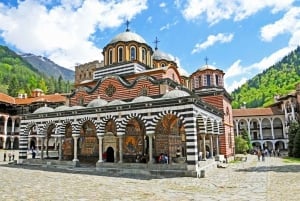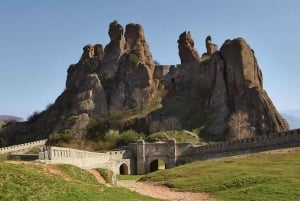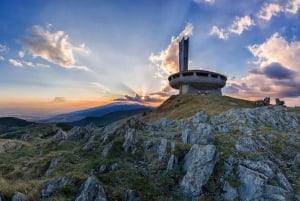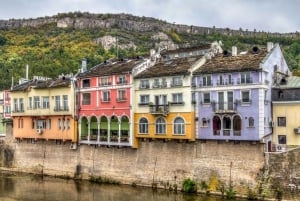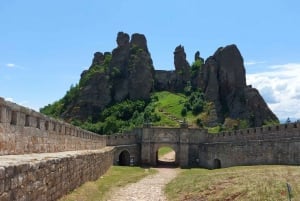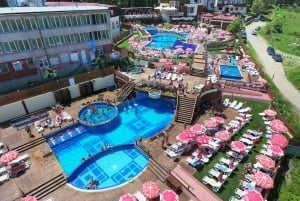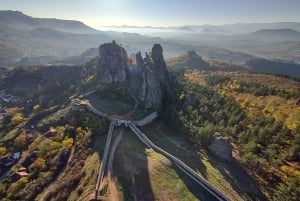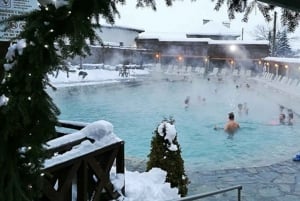Bulgaria Regional Info
Welcome to Bulgaria – our beautiful country ! Here we are at the doorstep of this postcard-sized country, about to embark upon an incredible voyage through mystical forests, golden shores, snowy peaks, ancient fortresses, heavenly monasteries and astounding natural wonders. Here we are on the brink of exploring one of the most attractive destinations in Europe. It is a place where civilization and nature meet to create the perfect blend between urban life and the great outdoors and where everything is within an arm's reach. The attractions the country offers are varied and exciting: skiing, windsurfing, hiking, spa, golf … these are just a few.
Bulgaria is among the most affordable destinations in Europe where the wishes of even the most exacting of tourists will be satisfied. And once visited, it will always give you something to come back for. Here we are…ready to get in. So let the journey begin.
General info:
Bulgaria lies at the heart of the Balkan Peninsula, building a bridge between the classy and sophisticated West and the colourful and friendly East and, quite naturally, is heavily influenced by both. The country was formed in 681 AD and this makes it one of the oldest in Europe and the world. Hence, the numerous historical and cultural monuments one will find there. In terms of territory, it occupies the mere 110,910 sq km which makes it a real tiny gem, offering so much with so little. Saying that you can do some hiking in the mountain in the morning, go see a play in the theatre in the afternoon and grab a bite in a restaurant on the seafront in the evening won’t be an exaggeration, on the contrary. But that’s not all. A couple of hours will be more than enough to complete your escape from the big city and dive in the solitude of some authentic little village where locals will greet you with the most delicious organic fruits and vegetables and homemade yogurt and cheese you have ever tasted. The most common starting point of every trip around Bulgaria is its capital city…
Sofia:
A bit more on the urban beauty of Bulgaria:
Sofia is not the only city to flaunt the beauty of urban Bulgaria. Plovdiv, the second biggest city in the country located 150 km southeast of Sofia, is a case in point. Situated on seven hills, just like Rome, this place has become a historical treasury that displays architectural monuments representative of the Thracian, Roman and Byzantine civilizations which all played part in its development, while the houses and the alleys of the Old Town provide detailed account on what urban life was like during the National Revival Period of the 19th century. Going further east, one will get to the two pearls of the Black Sea Coast: Varna to the north and Burgas to the south. Common tourist destinations in the summer, these two cities by the sea provide all sorts of entertainment for their visitors including sightseeing, theatre and museum-going and nightclubbing that only add up to the sea-related sunbathing, swimming, diving, wind and kitesurfing. Burgas is also host of the Spirit of Burgas music festival, one of the most popular festivals in Europe.The list is completed by two northern cities: Veliko Tarnovo, the former capital of Bulgaria, situated 220 km away from Sofia, and Ruse, the biggest Bulgarian city on the Danube River, nicknamed little Vienna.
Bulgaria's countryside - culture and traditions:
But Bulgaria is not only about the appeal of the urban areas. Those who are keen on learning more about Bulgarian traditions and customs should stop by some of the most famous rural destinations in the country. The town of Koprivshtitsa in central Bulgaria, together with its surrounding towns and villages, provides tourists with the most detailed information on the way Bulgarians used to live during and after the Ottoman Rule. Those who have a soft spot for traditional music and like the sound of bagpipes must visit the village of Shiroka Laka, a folklore and architectural reserve, located in the Rhodope Mountains just a couple of hours away from Sofia. And if you love trying typical national dishes you can always have lunch or dinner in one of Arbanasi’s many taverns where you will taste the best of Bulgarian cuisine. The village lies just outside Veliko Tarnovo.
The mountains and the sea:
These are Bulgaria’s most invaluable assets and also the greatest attractions for tourists. Apart from Vitosha, the mountain standing next to the capital city, there are about 35 more mountains on the territory of the country. The two giants Rila and Pirin, both national parks, are located in the southwestern part of the country. Their world-class ski resorts and numerous ecotrails make them great for skiing in the winter and hiking in the summer. Rila is also the highest mountain on the Balkans with its Musala Peak (2925 m), while Vihren Peak in Pirin is the second highest in the country – 2914m. The Rhodopes, Orpheus’s mountain, take up the bulk of Southern Bulgaria. They provide excellent opportunities for mountaineering, their villages preserve the traditional Bulgarian customs and folklore and their rocks keep substantial evidence of the Thracians who inhabited these places thousands of years ago. But perhaps most spectacular of all is Stara Planina – the Great Divide. Old Mountain, as the name translates into English, runs through the whole country separating the Danubian Plain to the north from the Upper Thracian Plain to the south and connecting the Bulgarian West to Black Sea. Botev (2376m), its highest peak, is named after Hristo Botev, one of the most iconic figures in Bulgarian history. The mountains are also perceived as important religious sanctuaries where tourists will discover some of Bulgaria’s most magical monasteries.
So, we finally reached it - the Black Sea Coast.
It runs along the entire Eastern border of the country, covering a distance of 378 km. And every summer thousands of tourists spend their vacations there. But why? Well, because it offers endless sandy beaches and great variety of attractions at affordable prices. Those who enjoy the peace and quiet can go up north to Krapets or down south to Sinemorets. The devoted campers can relax on the beaches of Smokinya, Arapya or Kavatsi. The fun-lovers can have their holidays in the entertainment centres Sunny Beach and Golden Sands. And the admirers of history, culture and religion can visit Nesebar, an architectural reserve and one of UNESCO’s world heritage sites, or Sozopol where the relics of St. John the Baptist are preserved. Of course there is still the beach, the sun, and the blue sea.
Natural wonders and mineral springs:
Our journey around Bulgaria is near its end but we have saved the best for last. The natural landmarks one will come across in this tiny little country are so many and diverse that it is absolutely impossible to go through all of them at once. They range from beautiful rock formations such as the Belogradchik Rocks (Belogradchishki Skali) in the northwest and the Standing Stones (Pobiti Kamani) near Varna, the Stone Mushrooms (Kamenni Gabi) in the south and the Lion’s Head (Lavska Glava) south of Burgas, to epic caves like Magura, Yagodinska, Devetashka and Ledenika, to gorgeous mountain lakes and reservoirs – Seven Rila Lakes, Batak, Kardzhali, to stunning gorges – Kresna and Trigrad. Seeing just some of them will make you feel very excited, if not breathless, and after that you will probably want to get some good rest. Bulgaria’s mineral SPAs will take care of that. If you really need a place where to relax and recuperate the country’s 225 mineral springs will provide you with plenty of options to pick from in terms of location and price and will allow you to enjoy the healing qualities of mineral water. Alternatively, you may prefer to loosen up with a club in hand. That wouldn’t be a problem because the country boasts some of the best golf courses in Europe.
Well, we visited many different places in Bulgaria and saw many different things, but there is still much more to see. The next journey starts here.
Photos by D.Alexov, E.Bliznashka


